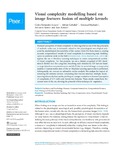Mostrar o rexistro simple do ítem
Visual complexity modelling based on image features fusion of multiple kernels
| dc.contributor.author | Fernández-Lozano, Carlos | |
| dc.contributor.author | Carballal, Adrián | |
| dc.contributor.author | Machado, Penousal | |
| dc.contributor.author | Santos, Antonino | |
| dc.contributor.author | Romero, Juan | |
| dc.date.accessioned | 2019-09-26T13:45:21Z | |
| dc.date.available | 2019-09-26T13:45:21Z | |
| dc.date.issued | 2019-07-18 | |
| dc.identifier.citation | Fernandez-Lozano C, Carballal A, Machado P, Santos A, Romero J. 2019. Visual complexity modelling based on image features fusion of multiple kernels. PeerJ 7:e7075 https://doi.org/10.7717/peerj.7075 | es_ES |
| dc.identifier.issn | 2167-8359 | |
| dc.identifier.uri | http://hdl.handle.net/2183/23991 | |
| dc.description.abstract | [Abstract] Humans’ perception of visual complexity is often regarded as one of the key principles of aesthetic order, and is intimately related to the physiological, neurological and, possibly, psychological characteristics of the human mind. For these reasons, creating accurate computational models of visual complexity is a demanding task. Building upon on previous work in the field (Forsythe et al., 2011; Machado et al., 2015) we explore the use of Machine Learning techniques to create computational models of visual complexity. For that purpose, we use a dataset composed of 800 visual stimuli divided into five categories, describing each stimulus by 329 features based on edge detection, compression error and Zipf’s law. In an initial stage, a comparative analysis of representative state-of-the-art Machine Learning approaches is performed. Subsequently, we conduct an exhaustive outlier analysis. We analyze the impact of removing the extreme outliers, concluding that Feature Selection Multiple Kernel Learning obtains the best results, yielding an average correlation to humans’ perception of complexity of 0.71 with only twenty-two features. These results outperform the current state-of-the-art, showing the potential of this technique for regression. | es_ES |
| dc.description.sponsorship | Xunta de Galicia; GRC2014/049 | es_ES |
| dc.description.sponsorship | Portuguese Foundation for Science and Technology; SBIRC; PTDC/EIA EIA/115667/2009 | es_ES |
| dc.description.sponsorship | Xunta de Galicia; Ref. XUGA-PGIDIT-10TIC105008-PR | es_ES |
| dc.description.sponsorship | Ministerio de Ciencia y Tecnología; TIN2008-06562/TIN | es_ES |
| dc.description.sponsorship | Ministerio de Ecnomía y Competitividad; FJCI-2015-26071 | es_ES |
| dc.language.iso | eng | es_ES |
| dc.publisher | PeerJ, Ltd. | es_ES |
| dc.relation.uri | https://doi.org/10.7717/peerj.7075 | es_ES |
| dc.rights | Atribución 3.0 España | es_ES |
| dc.rights.uri | http://creativecommons.org/licenses/by/3.0/es/ | * |
| dc.subject | Psychiatry and Psychology | es_ES |
| dc.subject | Human–Computer Interaction | es_ES |
| dc.subject | Computational Science | es_ES |
| dc.subject | Data Mining and Machine Learning | es_ES |
| dc.subject | Correlation | es_ES |
| dc.subject | Machine learning | es_ES |
| dc.subject | Zipf’s law | es_ES |
| dc.subject | Compression error | es_ES |
| dc.subject | Visual stimuli | es_ES |
| dc.subject | Visual complexity | es_ES |
| dc.title | Visual complexity modelling based on image features fusion of multiple kernels | es_ES |
| dc.type | info:eu-repo/semantics/article | es_ES |
| dc.rights.access | info:eu-repo/semantics/openAccess | es_ES |
| UDC.journalTitle | PeerJ | es_ES |
| dc.identifier.doi | 10.7717/peerj.7075 |
Ficheiros no ítem
Este ítem aparece na(s) seguinte(s) colección(s)
-
GI-RNASA - Artigos [195]






